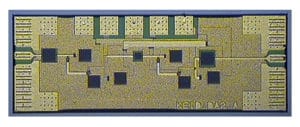A research collaboration between European scientists has yielded a breakthrough in wideband amplifier circuit design.
Researchers from University College London (UCL), UK and Chalmers University of Technology, Sweden have successfully designed and tested an amplifier that operates from low GHz frequencies to frequencies exceeding 235 GHz. The new amplifier also features a gain exceeding 15dB, which translates to a gain bandwidth product of approximately 1.5 THz. The researchers believe their new amplifier is at least twice as fast in terms of bandwidth as the fastest amplifier reported to date.

Professor Izzat Darwazeh, head of the Communications and Information Systems Group in UCL Electronic and Electrical Engineering, and Professor Herbert Zirath, head of the Microwave Electronics Laboratory at the Department of Microtechnology and Nanoscience at Chalmers, led the project. The development of the new circuit builds on previous research and design work completed by Zirath and Darwazeh over the past two decades, and is a large breakthrough in their effort to design circuits suited for communication at frequencies approaching the terahertz (THz) region.
“This achievement was possible both because of excellent technological advances in nanotechnology and state of the art design processes and techniques. This technology will help make ultrafast broadband possible for widespread use not only for communication systems but also for different scientific and test and measurement instrumentation,” Darwazeh said.
“This result is of considerable interest for the development of new products within the area of communication and instrumentation such as fast oscilloscopes, pulse amplifiers and fast fiber optic receivers,” Zirath added.
